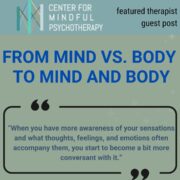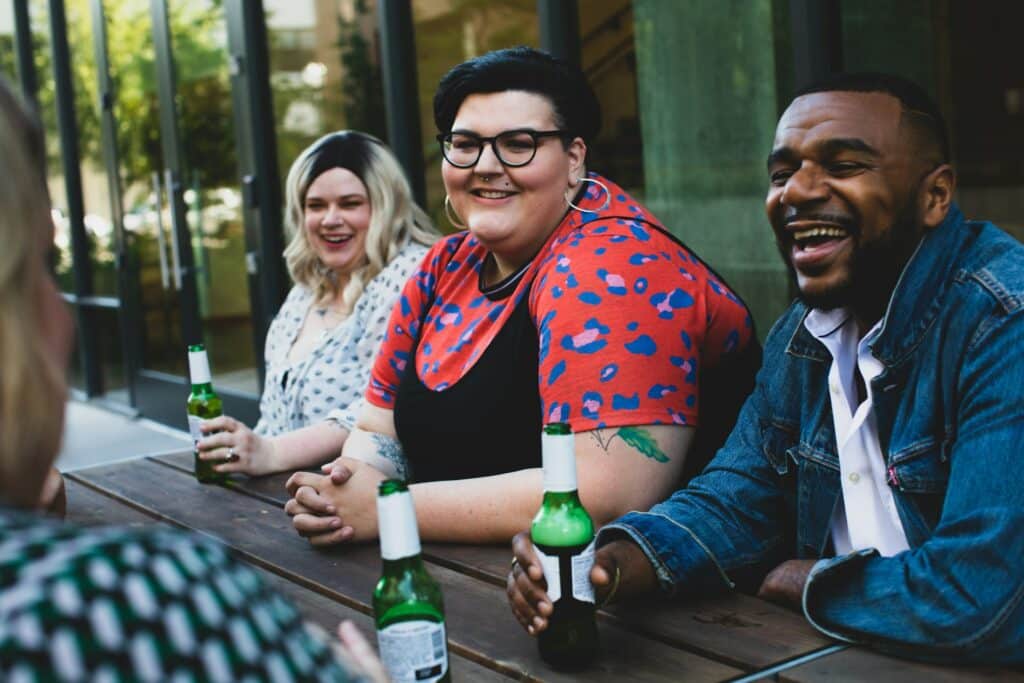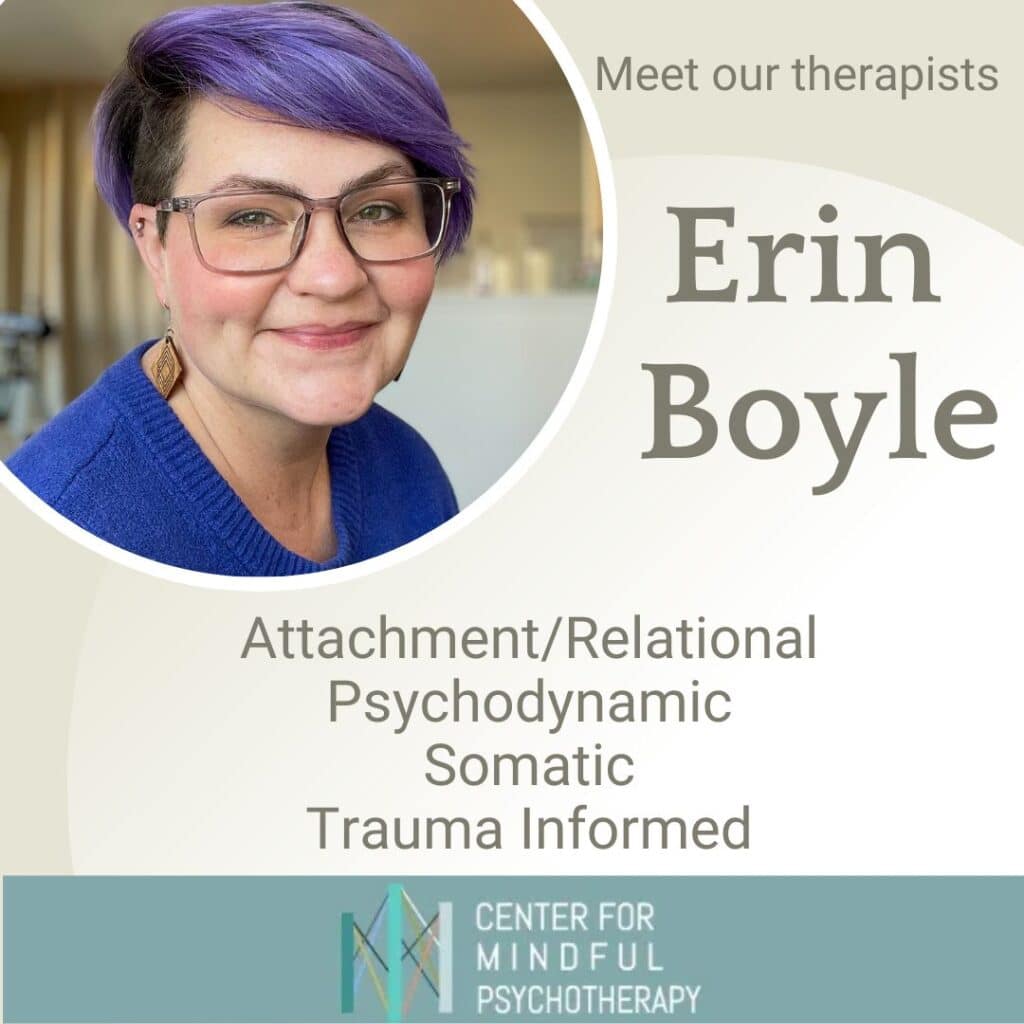

This is a guest blog post by associate therapist Erin Boyle. In this post, she shares insights from her personal journey of reconnecting with her body, explores the challenges many face in feeling “body-less,” and offers practical tools and therapeutic approaches to foster a deeper mind-body connection. You can learn more about Erin from this interview and see Erin’s therapist profile on our site here.
Mind vs. Body
For most of my life, I believed my biggest gift was my mind. Growing up, my mind earned me praise both at home and at school. I was lauded for being a great student, an honors kid, and someone who could “do anything they wanted.” At work as an adult, my mind was valued for its ideas, its ability to converse technically with engineers, and its slightly perfectionistic tendencies to make sure it all somehow got done.
My body, on the other hand, had long been a source of frustration and shame in my life. My body couldn’t hack it in gym class. My body was never the right size for middle school bullies who wondered out loud if I exercised. My body struggled to stay healthy and failed to perform its most basic of functions—breathing—for weeks on end as a chronically sick, asthmatic kid. My body was never praised for what it could do, and it certainly didn’t feel safe to be in.
During a therapy session about 5 years ago, a former therapist of mine asked, “What’s going on in your body as you tell me this?” To which I responded, “What body?” Yes, I was cognitively aware that I had a body, but at that moment I was completely unaware of any feelings or sensations happening in my body. In the battle of mind versus body, my mind seemed to be winning. And I was ok with that! Even as I started school to become a therapist, I thought I would simply not be the kind of therapist who works with the body.
And yet… my mind could never make up for the fact that I cried when I felt overwhelmed (despite how desperately I wanted to be able to control it). My mind couldn’t overcome how squirrely and upset my stomach felt when I was anxious about something. My thoughts couldn’t outrun my body anymore. It insisted that I start to pay attention.
Mind and body
When I began to pay more attention to my body and slowly befriended her, there were two terrifically surprising (to me) things that I learned: my body had really useful things to tell me, and my body could actively participate in making me feel better.
Body as a source of information
As I write this, my collarbone feels a little tender, my jaw tense, but my stomach feels spacious and loose. I can feel the soft carpet under my feet, and notice the coolness of the air in my apartment on my bare arms. I feel contemplative and curious (loose stomach, feeling present), with a note of “I hope I’m writing the right thing that will resonate with someone out there. I hope I have found adequate words to do this justice.” That last part is in my jaw and collarbone. What I’m writing feels good because it feels true. My body is telling me all sorts of things that I would otherwise miss.
What might your body be trying to tell you, right now?
When you have more awareness of your sensations and what thoughts, feelings, and emotions often accompany them, you start to become a bit more conversant with it. For example, if you learn what your body feels like when you feel certain, later you might recognize the feeling that comes with certainty before your mind is “made up.” Boy wouldn’t that save some time? Or perhaps you notice your stomach hurts and, because you know your stress usually shows up as a stone in your belly, you realize you’ve been really stressed out about work and need to engage with some self care. Your body can tell you really helpful things!
Body as a source of support
After over 30 years of believing my highly sensitive self would always be completely overwhelmed by intense emotions, I learned that my body can actively participate in supporting my feelings. I can alter my posture to call in strength, place a hand on my chest to support myself, or use grounding techniques to come back to the present moment. None of this takes away the emotion, but rather it lends me stability to get through it.
As it turns out, our bodies can help us in so many ways. They can help us feel more supported in everyday emotions, or help us weather the storm of the hard things in life. They can even provide us with moments of peace and safety in an otherwise dangerous world. Everybody is different, and every body is different, but with time, you can learn the ways in which your body can be a support for you.
Imagine it’s the holidays, and you’re visiting family. Your body is telling you that your anxiety is through the roof, but you now know that an hour laying on the floor mixed with some deep signal breaths will bring you back into balance and give you the stability you need to go back out there for round 3. Game changing.
The adaptive roots of “what body?”
I can tout the benefits of befriending your body all day, but I want to make sure we also address how we got to this “what body” point in the first place. There are so many reasons many of us feel “body-less” out there, and almost all of them have to do with keeping ourselves safe. Some of us grew up to believe our worth was solely in the realm of the cognitive. Some of us grew up with bodies from marginalized identities in a racialized, gendered, fat-phobic world, making the world literally unsafe for our bodies. Some of us have chronic pain or chronic illness, making our bodies places of discomfort. Some of us have bodies that are incongruous with our lived identities, or bodies that have been made disabled in an ableist world. Our bodies have been targeted, judged, abused, and attacked. We have learned that the body is not safe, the world is not safe for our bodies, and the most protective thing is for us to live entirely in our heads, in the world of the rational, in the world of the cognitive. That makes so much sense. We are just trying to survive in the best way we know how.
I say this because it’s important for you to know you’re not alone, none of this is your fault, and that there’s nothing wrong with you. In fact, by distancing your cognitive self from your body, your body has actually been doing exactly what it was designed to do in the face of danger (it’s trying to keep you safe). And if the idea of reconnecting to your body still feels overwhelmingly threatening, you do not have to do it. (Seriously. It may not be the right time for you. That is ok!) But if it feels merely scary (but not overwhelmingly so), or maybe you’ve never even considered having a real relationship to your body as a possibility, consider this your gentle invitation to simply imagine a different way of being.
How I work with the body in therapy
It’s all about consent
While I believe strongly in incorporating the body and your bodily experiences into therapy, I will always go at your pace and ask for consent every step of the way. For example, I might say something like, “I’m wondering if it might be helpful for us to pause and take some deep breaths together. Would that feel ok?” If you say “no thanks” or “nope” or “abso-fucking-lutely not,” we will not take those deep breaths together. Or, if you say something like, “ok, I guess” but your body language indicates to me that you might not be fully on board with this plan, I might say, “hmm, it seems like maybe that’s a no,” and then we won’t take those deep breaths together. The number one rule about working with your body in therapy is that you are in the driver’s seat.
Noticing with curiosity
More often than not, I might ask you questions like, “as you feel that emotion or have that thought, what’s happening in your body?” If your response is “what body?” that’s great noticing! Over time, we will begin to practice shifting our awareness to the body, and look for any pains, tensions, sensations of heat or cold, moving energy and the quality of that movement, etc. When we begin to notice sensations in the body, we do so with a sense of gentle curiosity. In other words, we are not judging the reaction your body is having, nor are we trying to change the sensations your body is experiencing. We are simply noticing, naming, and thinking, “hmm, I wonder what that’s about?”
Tools and exercises
Sometimes I will also offer tools or little techniques we can try together that might help you feel more present, calm, or safe. Once again, it is always ok to say “no” when I offer something to try, and some of my clients prefer when I demonstrate the tool for them first before they decide whether or not they’d like to try it. And some of my clients prefer to try the technique outside of therapy, if it’s feeling too vulnerable to try it in session. Examples include changing your body posture, using your fingers to tap on specific parts of your own body, or using pressure from your hand to make contact with your belly, chest, or arm. It really all depends on what’s happening in the session and what I think might be useful and supportive to you in the moment.
Curious about reconnecting with your body?
If you’re curious about reconnecting with your body, that’s fantastic! I want to encourage you to be gentle with yourself, have patience, and go slowly. This work does not happen overnight, and it’s really important that you approach this with delicacy. If you can, I highly recommend working with a mental health professional on this journey. (And, if you happen to be in California, I am currently accepting new clients.)
I’ve also linked to a few resources below that you might find helpful in your journey. Remember that the first step is simply to notice with compassionate curiosity. So check in with yourself—what’s happening for you right now as you’re reading this? Is there, perhaps, a flutter of excitement in your chest? A twinge in your neck of apprehension? A twisting belly of fear? You don’t need to change it. Simply notice.
Resources:
- Book: Becoming Safely Embodied: A Guide to Organize Your Mind, Body and Heart to Feel Secure in the World by Deirdre Fay
- Video: Salamander exercise
- Video: Signal breaths
- Video: Introduction to tapping




